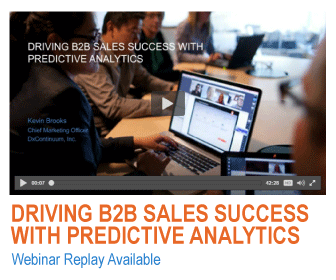By Dr. Kannan Govindarajan, Co-founder and Chief Product Officer
A few months ago, on this blog, we hypothesized that using an active CRM system that helps sales organizations focus on fewer more winnable opportunities can result in increased sales velocity. The basis of the hypothesis was that the Pareto principle roughly applies to opportunities at the beginning of the quarter, and organizations that could identify the winnable opportunities early, can use it to increase their sales velocity.
Opportunity Pareto Principle
In order to determine whether this is likely to be true, we ran a virtual experiment with one of our customers where we looked at what would happen if the sales organization only focused on the opportunities that were deemed winnable by DxContinuum's DxC SalesSuite at the beginning of the quarter. What we saw was astonishing. The answer is yes. The Pareto principle applies to opportunities in the beginning of the quarter (we can identify 50% that accounted for 85% of the eventual revenue) and consequently, Velocity can increase by almost 25%.
How is this possible? To recap, sales velocity is defined as (Number of opportunities * Average Deal Size * Win Rate)/(Length of Sales Cycle)
DxC SalesSuite identified about half the opportunities as 'worth pursuing' at the beginning of the quarter. These winnable opportunities had an average deal size that was 64% higher the average deal size over the entire set. In addition, about 80% of the opportunities eventually won were also classified as 'worth pursuing', which meant that the win rate among the opportunities declared to be worth pursuing was 50% higher. In fact, the opportunities that were classified as winnable and were eventually won made up 85% of the revenue in the quarter. There was no appreciable difference in the average sales cycle for the opportunities classified as winnable.
This means that in spite of reducing the number of opportunities in the funnel by 50%, this company could increase the sales velocity by almost 25% if they had focused just on the opportunities deemed winnable by DxC Sales Suite. The key capability that makes this possible is DxContinuum's ability to quantify the quality of each opportunity that is based on its likelihood to result in a win.
I know what you are thinking, what about the 20% of the wins that were not classified as winnable by DxContinuum's DxC Sales Suite? How can the 15% revenue leakage be minimized? Why was the sales cycle not shorter for the winnable opportunities? We have had cases where 80% of the opportunities that we predicted they would win at the beginning of the quarter were actually won by the end of the quarter. Stay tuned to this blog for those additional insights.
In summary, while the Pareto principle in sales is well accepted when applied to customers, i.e., 20% of customers generate 80% of revenue, our case study suggests that it also applies at a more granular level, i.e., at the opportunity level. Are you ready to take advantage and substantially increase your sales velocity and revenue? Take a look at DxContinuum's DxC Sales Suite and let us know if we can help your sales organization increase its sales effectiveness.




